| |
HAMERKOP Scopidae |
- 1 species in sub-Saharan Africa
- DR personal total: 1 species (100%), 1 photo'd
|
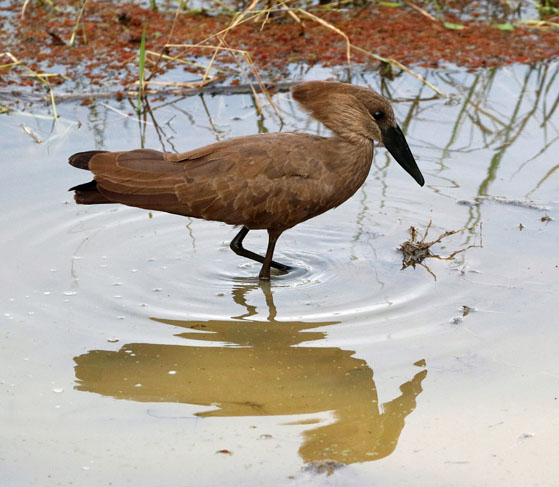 The Hamerkop (all photos) is the sole member of its family, endemic to sub-Saharan Africa, plus southwest Arabian Peninsula and in Madagascar. It is a denizen of marshy shorelines of lakes, rivers, and estuaries, hunting mostly frogs and tadpoles, but will gobble down small fish, worms, and insects when encountered. In a small forest mud-hole in Tanzania, we watched one wade into the pool, and use its feet to stir the bottom, then grabbing whatever appeared at the surface (left). Another Hamerkop in Ruaha NP, Tanzania, appear to catch a small fish at river's edge (below). The Hamerkop (all photos) is the sole member of its family, endemic to sub-Saharan Africa, plus southwest Arabian Peninsula and in Madagascar. It is a denizen of marshy shorelines of lakes, rivers, and estuaries, hunting mostly frogs and tadpoles, but will gobble down small fish, worms, and insects when encountered. In a small forest mud-hole in Tanzania, we watched one wade into the pool, and use its feet to stir the bottom, then grabbing whatever appeared at the surface (left). Another Hamerkop in Ruaha NP, Tanzania, appear to catch a small fish at river's edge (below).
The origins and relationships of the Hamerkop were once obscure. Elliott (1992) summarized what is known at that time: "Superficially the Hamerkop's bill recall those of both the Shoebill Balaeniceps rex [of Africa] and the Boat-billed Heron Cochlearius cochlearius [of the Neotropics], but this is normally attributed to convergent evolution. It has pectinated middle toe as in the herons, a free hind toe as in the flamingos, egg-white protein like the stocks and yet ectoparisites which are only otherwise found in plovers. To confuse matters further, its habits and behaviour are unique, leaving taxonomists with little option but to place it in it own monospecific family."
More recent molecular research shows that Hamerkop is in the Pelecaniformes, and most closely related to the Shoebill; Mayr (2003, 2011), Hackett et al. (2008).
|
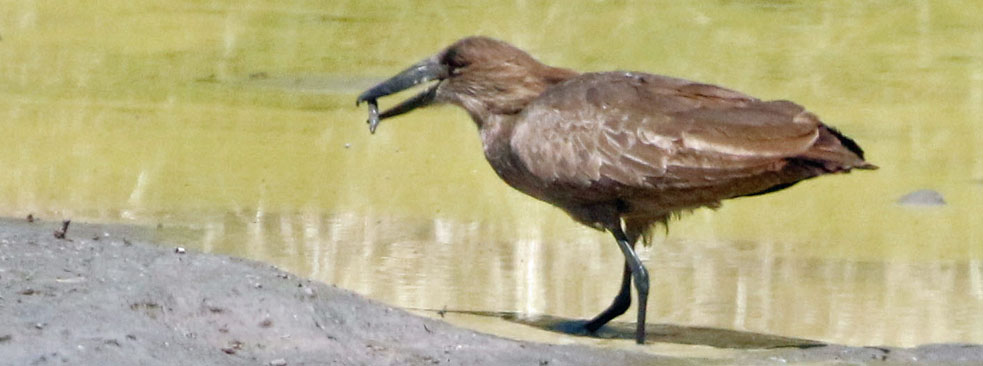 |
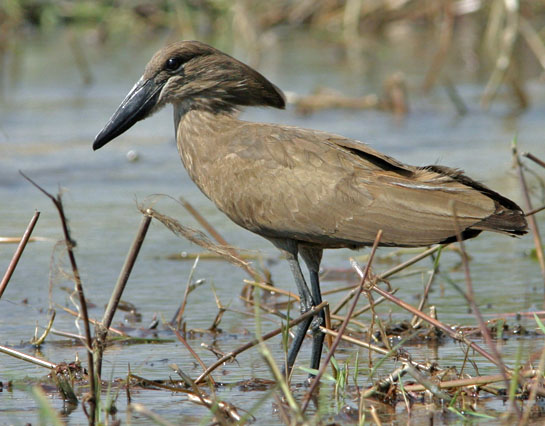 The Hamerkop is smaller than a night-heron, perhaps crow-sized, but slimmer and longer in shape, with a weird broad bill balanced against a pointy crest out the nape, leading to an English alternate name "hammer-head." These characters show well on this photo from the Okavango Delta (right). The Hamerkop is smaller than a night-heron, perhaps crow-sized, but slimmer and longer in shape, with a weird broad bill balanced against a pointy crest out the nape, leading to an English alternate name "hammer-head." These characters show well on this photo from the Okavango Delta (right).
The word "Hamerkop" is the equivalent in the Afrikaans language (of Dutch-German origins). I freely admit that until this very day in 1999 when I first created this page, I had consistently misspelled the name as "Hammerkop," and I still pronounce it "hammer + cop."
The crest is erectile when anxious or excited. This pair on a Tanzanian river are perhaps cautious when passing the Rufous-bellied Heron (below).
|
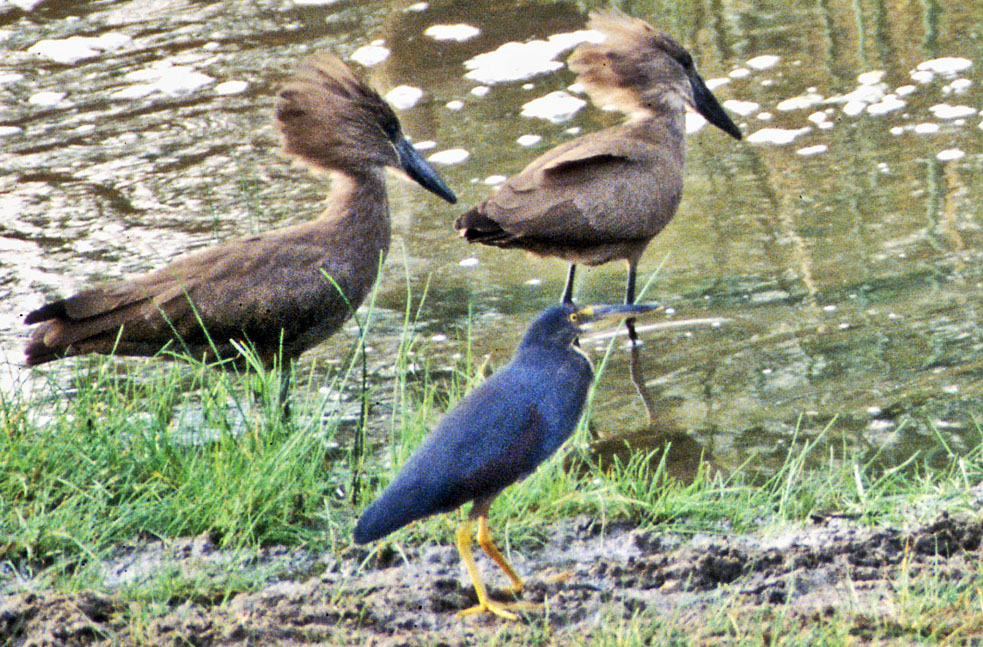 |
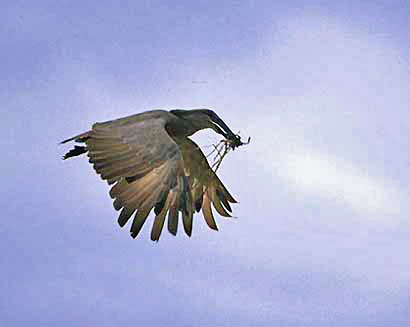 Hamerkops are known for their huge bulky nests that can be seen for miles. Hamerkops roost and nest in large isolated trees. This one in flight is carrying vegetation to continue work on such a nest, which is a central chamber inside a huge elaborate pile of reeds, grass, and sticks. Hamerkops are known for their huge bulky nests that can be seen for miles. Hamerkops roost and nest in large isolated trees. This one in flight is carrying vegetation to continue work on such a nest, which is a central chamber inside a huge elaborate pile of reeds, grass, and sticks.
Hamerkop is a common and familiar bird throughout Africa south of the Sahara. It adapts rather well to the presence of man, and it is revered by many local tribes. It has been claimed that is the origin of more legends and superstitions than any other bird. It is considered "magical" because of its large, impregnable, inaccessible and therefore mysterious nest (Elliott 1992). Often claimed to be nocturnal, it is actually active only during the day. But, like many African birds, it feeds in the cool of the dawn and dusk, and roosts calmly during the heat of the day. My friend Terry Stevenson is an expatriate Brit and now a famed east African birder. When I first met him in 1981, he was the "resident ornithologist" at Lake Baringo Lodge in Kenya. Here he had a house on the lake. He tells me that a wild Hamerkop has adopted this homestead as its own, wandering at will into portions of the house, and paying little attention to the human inhabitants. I know of no other birder who can claim such a house pet. |
Single pairs build these stick nests — and may actually build multiple such nests, some of which are abandoned. They build a new one each year in the breeding season, which can be any month year-round, but generally after the long rains or in the dry season. The nests are so substantial that they provide resting place and shelter for many other animals. Hamerkops are revered in many local cultures for setting a good example with dedicated parenting.
Although most pairs nest in isolated trees, there are times when semi-gregarious nesting colonies may form in locations that provide abundant food. Up to 56 nests were located at a single in Queen Elizabeth II NP in Uganda (Kaweesa et al. 2013).
As luck would have, I have a photo of a Hamerkop in Queen Elizabeth II NP (below). It was along the edge of the famed Kazinga Channel, and was taken from a tour boat on the channel. This shot shows not only the hammer-shaped crest but the heavy bill, strong legs, and long facial feathers. |
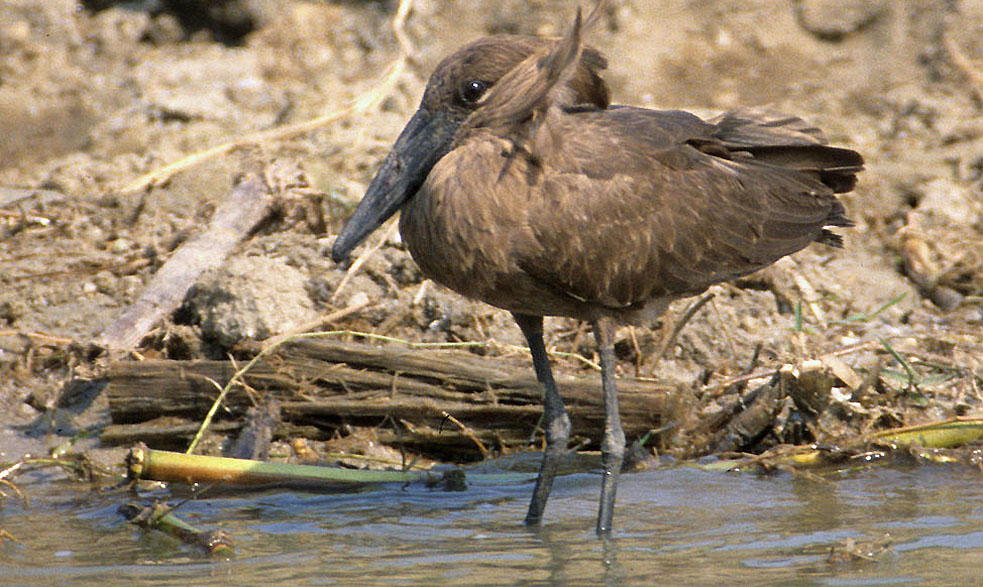 |
| |
Photos: All photos show Hamerkop Scopus umbretta in Africa. The foraging Hamerkop was in Mikumi NP, Tanzania, on 11 July 2021, and the one with prey was in Ruaha NP, Tanzania, on 5 July 2021. The bird from the Okavango Delta was near Xero Lodge, Botswana, on 24 July 2005. The pair near Rufous-bellied Heron Ardeola rufiventris were in Tarangire NP, Tanzania, on 6 Aug 2002. The nest-building bird in flight was at Lake Baringo, Kenya, on 16 Nov 1981. The last shot is from the Kazinga Channel, Queen Elizabeth II NP, Uganda, on 24 July 2002.
All photos © Don Roberson; all rights reserved.
Bibliographic note: There is no "family book" per se, but a fine introduction to this family, with some good photos, is in Elliott (1992). As always with African species, a very useful entrée into this species is in Brown, Urban & Newman (1982).
Literature cited:
Brown, L.H., E.K. Urban, and K. Newman, eds. 1982. The Birds of Africa. Vol. 1: Ostriches to Birds of Prey. Academic Press, London & New York.
Elliott, A. 1992. Family Scopidae (Hamerkop) pp. xx–xxx in Handbook of the Birds of the World (del Hoyo, J., A. Elliott &J. Sargatal, eds). Vol. 1. Lynx Edicions, Barcelona.
Hackett, S.J., R.T. Kimball, S. Reddy, R.C.K. Bowie, E.L. Braun, M J. Braun, J.L. Chojnowski, W.A. Cox, K.-L. Han, J. Harshman, C.J. Huddleston, B.D. Marks, K.J. Miglia, W.S. Moore, F.H. Sheldon, D.W. Steadman, C C. Witt, and T. Yuri. 2008. A phylogenomic study of birds reveals their evolutionary history. Science 320: 1763–1768.
Kaweesa, S.H., R.J. Jonkvorst, R. Katebaka, R. Ssemmanda, D. Pomeroy, and J. Brouwer. 2013. Is the Hamerkop Scopus umbretta a neo-colonist or an opportunist nester? Scopus. 32: 35–38.
Mayr, G. 2003. The phylogenetic affinities of the Shoebill (Balaeniceps rex). Journal für Ornithologie 144: 157–175.
Mayr, G. 2011. Metaves, Mirandornithes, Strisores and other novelties — a critical review of the higher-level phylogeny of neornithine birds. J. Zool. System. Evol. Research 49: 58–76.
|
|
|




 The Hamerkop (all photos) is the sole member of its family, endemic to sub-Saharan Africa, plus southwest Arabian Peninsula and in Madagascar. It is a denizen of marshy shorelines of lakes, rivers, and estuaries, hunting mostly frogs and tadpoles, but will gobble down small fish, worms, and insects when encountered. In a small forest mud-hole in Tanzania, we watched one wade into the pool, and use its feet to stir the bottom, then grabbing whatever appeared at the surface (left). Another Hamerkop in Ruaha NP, Tanzania, appear to catch a small fish at river's edge (below).
The Hamerkop (all photos) is the sole member of its family, endemic to sub-Saharan Africa, plus southwest Arabian Peninsula and in Madagascar. It is a denizen of marshy shorelines of lakes, rivers, and estuaries, hunting mostly frogs and tadpoles, but will gobble down small fish, worms, and insects when encountered. In a small forest mud-hole in Tanzania, we watched one wade into the pool, and use its feet to stir the bottom, then grabbing whatever appeared at the surface (left). Another Hamerkop in Ruaha NP, Tanzania, appear to catch a small fish at river's edge (below). The Hamerkop is smaller than a night-heron, perhaps crow-sized, but slimmer and longer in shape, with a weird broad bill balanced against a pointy crest out the nape, leading to an English alternate name "hammer-head." These characters show well on this photo from the Okavango Delta (right).
The Hamerkop is smaller than a night-heron, perhaps crow-sized, but slimmer and longer in shape, with a weird broad bill balanced against a pointy crest out the nape, leading to an English alternate name "hammer-head." These characters show well on this photo from the Okavango Delta (right).  Hamerkops are known for their huge bulky nests that can be seen for miles. Hamerkops roost and nest in large isolated trees. This one in flight is carrying vegetation to continue work on such a nest, which is a central chamber inside a huge elaborate pile of reeds, grass, and sticks.
Hamerkops are known for their huge bulky nests that can be seen for miles. Hamerkops roost and nest in large isolated trees. This one in flight is carrying vegetation to continue work on such a nest, which is a central chamber inside a huge elaborate pile of reeds, grass, and sticks.